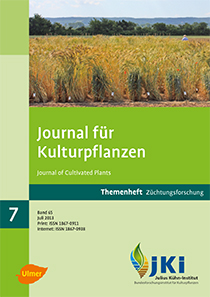Broadening the genetic base of leaf rust (<em>Puccinia triticina</em> f. sp. <em>tritici</em>) resistance in wheat (<em>Triticum aestivum</em>)
DOI:
https://doi.org/10.5073/JfK.2013.07.02Keywords:
Wheat, Puccinia triticina, Triticum monococccum, Leaf rust resistance, Pre-breedingAbstract
Leaf rust (Puccinia triticina f. sp. tritici) causing yield losses up to 60% in susceptible cultivars is of worldwide importance. The most cost efficient and environmental sound way to avoid these losses is growing of resistant cultivars. In order to get information on the usability of leaf rust resistance genes (Lr-genes) in Germany, near isogenic lines (NILs) carrying different resistance genes were investigated. Virulent isolates were detected on NILs carrying the Lr-genes Lr2c, Lr3a, Lr3bg, Lr3ka, Lr10, Lr13, Lr14a, Lr15, Lr17, Lr20, Lr26, and Lr37 in field trials. In summary only very few Lr-genes (i.e. Lr9 and Lr24) showing complete resistance are available in order to broaden the genetic base of leaf rust resistance in wheat in Germany. However, the evaluation of genetic resources led to the detection of a race non-specific pre-haustorial resistance in Einkorn wheat (Triticum monococcum). In detailed molecular and microscopic analyses an increased peroxidase activity and expression of the pathogenesis related gene 1 (Pr1) was detected in the resistant Einkorn accession. Furthermore, by microscopic analyses a decrease or complete inhibition, respectively of haustorial mother cell development was shown as well as the fast accumulation of hydrogen peroxide, phenolic substances and lignin. In order to get information on the genetics of this resistance a molecular map of 680.6 cM comprising 371 markers has been developed. Phenotyping of the F2 and F3 is in progress and will lead to the identification of QTL facilitating a marker based transfer of this horizontal resistance into T. aestivum.
Downloads
Published
Issue
Section
License
The content of the journal is licensed under the Creative Commons Attribution 4.0 License. Any user is free to share and adapt (remix, transform, build upon) the content as long as the original publication is attributed (authors, title, year, journal, issue, pages).
The copyright of the published work remains with the authors. The authors grant the Journal of Cultivated Plants, the Julius Kühn-Institut and the OpenAgrar repository the non-exclusive right to distribute and exploit the work.







